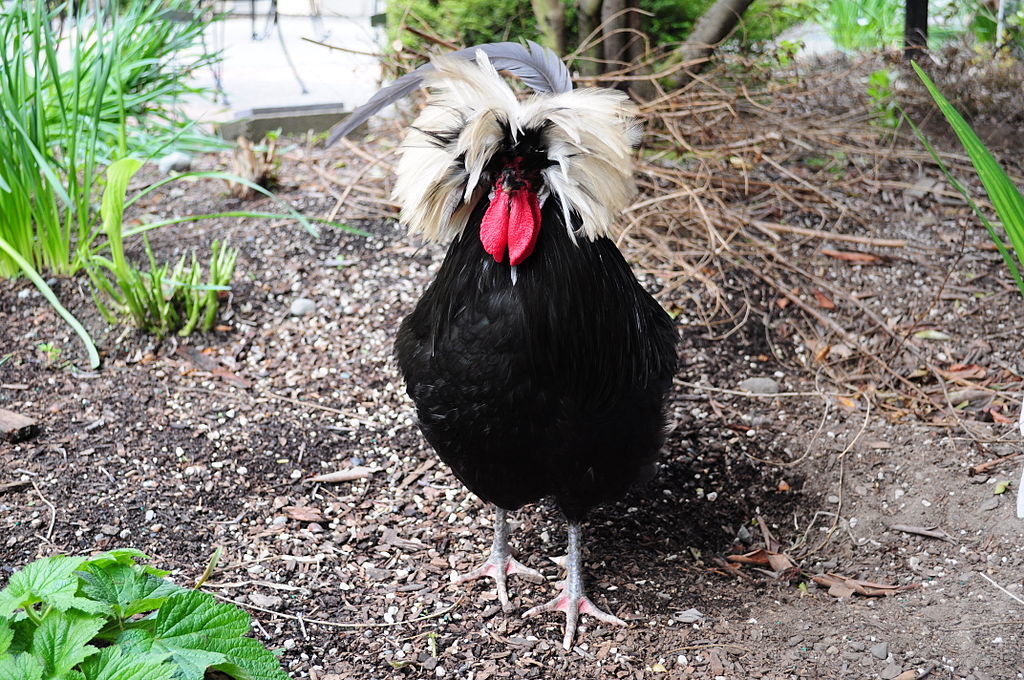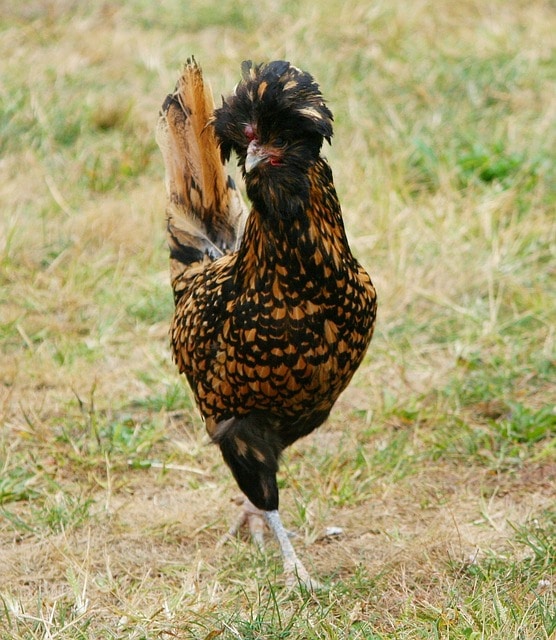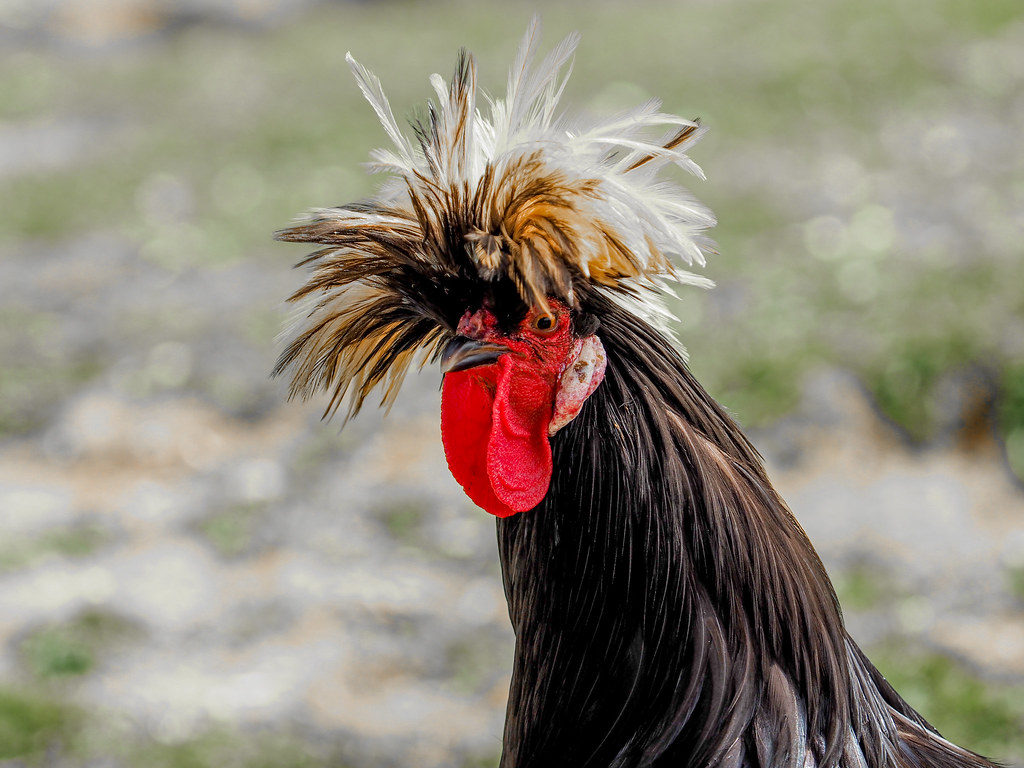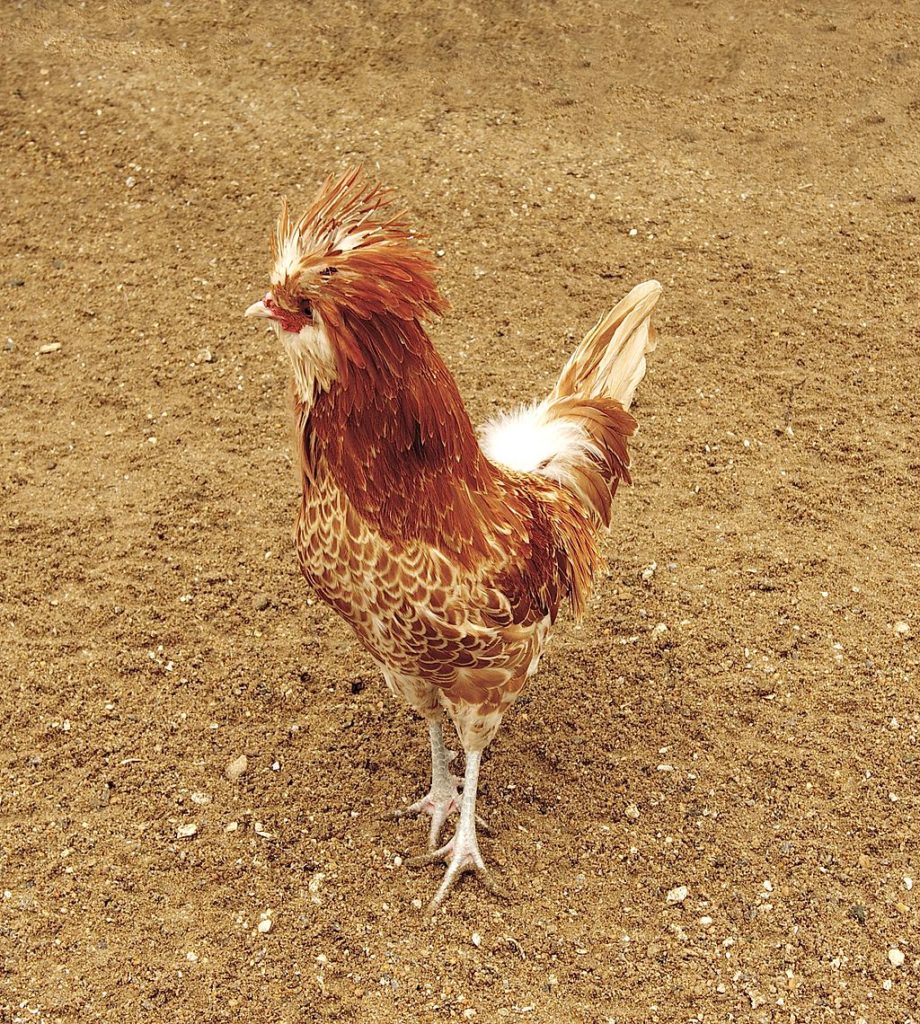Polish chickens are quirky and bizarre, but most importantly, they are super charming. They can be distinguished by their beautiful head feathers.
The Polish chicken breed offers good looks (albeit some unusual ones), a peaceful demeanor, and plenty of production.
This breed has a storied history and could quickly become the star of your backyard chicken coop.
There’s no chicken quite like the Polish breed – but do you have what it takes to raise one?
Continue reading to learn more about this exceptional chicken.
Table of Contents
Polish Chickens Overview
Before we dive into the details of this unique breed, here’s an overview of its characteristics.
| Lifespan | 7 to 8 years |
| Weight | 4.5 to 6 pounds |
| Appearance | A variety of colors with fluffy head feathers |
| Egg Production | 3 to 4 per week, 150 to 200 per year |
| Egg Color | White |
| Good for Beginners? | Yes |
| Minimum Coop Size | 4 square feet per bird |
| Price | $4 to $5 per chick |
History of the Breed

As with many breeds of chicken, it’s not clear where this bird actually came from.
One commonly circulated theory is that the ancestors of the bride were brought by Asian Mongols to Eastern and Central Europe during medieval times.
As a result, the breed could very likely have originated in Poland.
An alternative theory is that immigrants brought the breed’s ancestors from Italy or Spain in the late 16th century.
Either way, the breed was standardized and recognized in the Netherlands, where it was later declared a thoroughbred.
This breed is one of the few whose reputation is firmly ensconced in history – there are chickens that look to be Polish chickens in paintings from the 1500-1700s.
The birds were prized by French aristocracy, kept for their elegant appearance and brought to this country by the King of Poland, when he was dethroned and had to flee to France.
He carried these chickens in his luggage with him!
There are a lot of arguments over where the Polish chicken came from. Some people agree that the breed is truly Polish, while others think that the Polish chicken may have instead been in a Polish territory or another country, like the Netherlands.
Why would the Polish chicken be named as such if it didn’t originate in Poland?
One theory is that the bird was named because it has a large head and the Dutch word “pol” means just that.
In France, these chickens are known as one of the best egg-producing breeds.
This is an interesting tidbit that many American chicken producers aren’t aware of because Polish chickens aren’t typically regarded for exceptional egg production.
While they were originally imported to the United States as a layer of white eggs, it was eventually surpassed by the White Leghorn, which is now the most popular commercial egg-laying breed.
However, the American Poultry Association adopted three Polish varieties to the Standard of Perfection in 1874, with additional variations accepted in subsequent years.
This chicken can also go by the name of Poland, Tophat, or Paduan chicken, though the Polish moniker is the most commonly used.
Appearance

The Polish chicken, like many breeds of chickens, can be found in both standard and bantam size, both of which are recognized by the American Poultry Association.
Classified as a Continental breed, the colors and types of Polish chickens are recognized as such:
- Non-bearded white-crested black
- Non-bearded golden
- Non-bearded white
- Non-bearded silver
- Bearded golden
- Bearded white
- Bearded silver
- Bearded buff laced
- Non-bearded buff laced
- Non-bearded white crested blue
Though not yet accepted by the American Poultry Association, the Tolbunt is one of the most recently recognized and most stunning varieties of Polish chicken.
This bird has a mixture of brown, white, and black feathers and is quite exquisite to behold.
Despite the variation in colors and patterns, you will definitely know a Polish chicken when you see one.
These hens have distinct pom-pom hairdos that appear to be neatly groomed and coiffed.
Roosters, on the other hand, are a bit more disheveled, looking as though they are having a bad hair day.
The head feathers of both genders of chicken will become long, cascading over their faces and sometimes causing problems with sight.
The crest of the head has a bony prominence that rises up out of the skull, and some Polish chickens are bearded, too (though not all).
Roosters have bizarre red v-shaped combs along with white earlobes and red wattles. Interestingly, these chickens have gray legs with four tees on each foot.
The legs and feet do not have feathers.
These chickens are not giants, typically only grow to about six pounds in a rooster and four and a half in a hen. The skin is a typical white color.
Personality

Polish chickens are known to be some of the calmest and gentlest birds.
An excellent choice for backyard chicken keepers who have children or other pets, this bird, too, makes a fantastic pet for your family.
Some people even raise them indoors!
These chickens have a tendency to be a bit flighty. You can clip their wings, but this is not recommended if you plan on showing your bird in an exhibit because clipping wings can sometimes lead to disqualification – check the standards of your intended show to see if this might apply to your bird.
A Polish chicken that is given unrestricted room to roam may show up in odd places – if given the opportunity, it will even roost in the trees!
In addition, these birds can sometimes become nervous. This is usually due to the chicken’s visual problems.
You might want to trim the head feathers around the facial or ocular area of the bird to help it see predators.
This can also help prevent eye infections, to which this bird is prone.
If you don’t want to trim feathers around the eyes, either for personal reasons or exhibition reasons, you can help ease your Polish chicken’s nerves by talking gently or whistling to it as you approach.
This will let your bird know that you are coming, helping to reduce its startled demeanor.
Polish hens rarely go broody, but this varies among individuals.
They are typically bred for exhibition or as pets, but there is still some natural variation in the genetics.
Some birds are better layers while others veer toward broodiness.
These curious birds are known to be quite inquisitive. Often, they’ll end up trapped somewhere and will need your help to get out.
This is especially true if they become separated from the flock and can’t see.
While they aren’t known for being noisy birds, they will often squawk loudly until the other hens find them or hear them.
These chickens are low on the pecking order, since they are so calm and have such luxurious head feathers.
Despite that, these chickens are good foragers.
They will do a nice job of finding their own food and entertainment, so you shouldn’t have to worry about feeding them as much food – although a healthy pellet or other layer-specific feed is still recommended.
Is the Polish Chicken a Good Egg Layer?
Polish chickens originated for their so-called dynamic egg laying ability, but unfortunately, despite individuals of the Polish breed laying a good amount of white medium-large eggs, they are just not consistent across the breed.
While some chickens will do a great job with a high egg production, others will not be so prolific. So, Polish chickens are about average for egg laying.
On average, these birds will lay about 3 to 4 eggs per week. Usually, they lay 150 to 200 eggs per year.
They rarely go broody, but there have been reports of them doing so occasionally.
However, there’s not enough evidence to suggest whether Polish hens make good mothers, since the incidence of them going broody and hatching their eggs is so rare that evidence is quite anecdotal.
If you’re trying to increase the egg production of your Polish chicken, there are a few “hacks” you can incorporate.
All of them are safe for your bird and can help stimulate natural egg laying. Here are some ideas:
- Put a white false egg or a golf ball in your nest boxes
- Ensure that there are plenty of nest boxes filled with clean, soft bedding for all your birds
- Hang curtains over your nest boxes to provide extra privacy
- Add a calcium supplement, like oyster shell, to your chickens’ diet
- Make sure there are not stress-causing influences on the flock, such as predators nearby or aggressive flock mates
Is the Polish Chicken Good for Meat Production?
Unfortunately, due to its small size, the Polish chicken is not a great option for meat production.
While there have been some reports of people culling members of their flock and using the resulting bird as a meat bird, you won’t get a lot off the Polish chicken’s small carcass.
You would be better off raising this chicken for eggs, as we have mentioned.
Breeding Your Polish Chickens
It can be tough to encourage natural breeding in your Polish chickens – not because the roosters won’t mate with the hens, but because the hens are unreliable sitters that won’t often hatch their own chicks.
You can encourage hatching by removing eggs and hatching your own in an incubator.
This is not difficult to do – Polish eggs remain fertile for several days after being laid.
The second biggest challenge in breeding Polish chickens is that the roosters can be overly aggressive during the mating process.
It’s common for roosters of all breeds to pull the feathers of a hen while he is mating with her. This is especially true with the Polish chicken.
If you notice any poor hen that is receiving too much attention, you can remove her from the breeding pen to a new location.
The eggs will remain fertile after being bred, so you can still collect them for incubation.
If collecting your own hatching eggs isn’t for you – for example, if you aren’t able to keep a rooster in your flock due to zoning laws – you can always purchase hatching eggs online and still be able to incubate your own at home.
Does the Polish Chicken Have Any Breed-Related Health Problems?
Polish chickens, unfortunately, aren’t known for being the healthiest chickens.
The chicks in particular need to be observed and monitored closely during the first few weeks of life.
Because they have an extremely bony head prominence, there is imminent danger during the first weeks after hatching.
The prominence does not fuse together right way, so if your chicks engage in any pecking behavior, know that a single peck could kill or damage your chick.
In addition, you will want to check the beard and crest of your bird on a regular basis.
Because these chickens have such lush feathering, it is entirely possible for the feathers to become infested with lice, mites, or other parasites.
You can reduce the risk by providing treatments and by trimming back any overgrown feathers.
If you’re worried about your chicken sustaining any injuries related to feather pulling or mite infestation, there’s a good solution to your problems.
When you notice that your Polish chicken has feathers that have been pulled out, and that there are bloody or exposed areas of skin, apply some Blue Kote.
Chickens are naturally attracted to bloody areas and will peck unrelentingly or even exhibit cannibalistic behavior when given this opportunity.
Blue Kote will not only help cover up the red, but it will also form a seal to keep bacteria out of the wound. Your chicken will be allowed to heal in the meantime.
Just keep in mind that Blue Kote stains, so your chicken might look a little odd for a while.
Otherwise, these chickens won’t vary too much from other chickens in terms of their susceptibility to various diseases.
If you are planning on exhibiting your Polish bird, you may have to expend some extra effort in keeping your chicken clean, groomed, and coiffed according to the Polish breed standards.
For more information on showing your bird, make sure you check out the Polish Breeders Club.
Ideal Environment for Polish Chickens
Polish chickens do well in confinement, not needed a ton of extra space due to their size. They need at least four square feet per bird in their coop, but they need lots more outside the coop.
They need dry quarters during the winter months and aren’t the best chicken for extremely wet or cold weather.
The feathers on the birds’ heads can easily become wet and frozen, with this dense feathering not drying out well during times of inclement weather.
As long as you keep your Polish chicken in a draft-proof building during areas of extreme cold, you should be okay.
They won’t like being wet, and if they become sodden you will need to help them dry out their fluffy head feathers.
You could also put a heat lamp in your coop to help warm it up during times of damp weather.
They should do just fine in hot weather, although you will want to provide them with plenty of shade and fresh, clean water.
These birds do well when cooped up, as we mentioned, but you will want to keep it in a covered run for its safety.
It has a tendency to be quite curious, and since its eyesight is hindered by its dense feathering, it can easily run into problems with other chickens, pets, or even predators.
You don’t need a large coop, but you should make sure your chickens have enough space to get way from larger birds if there is any flock tension.
Because chickens naturally become more aggressive when they are confined, you will need to worry about the safety of your Polish chicken should it be subjected to life in close quarters.
If you’re concerned about raising your Polish chicken in a mixed flock, consider keeping it with breeds that are similarly ornamented or have similar behavioral characteristics.
Here are some good breeds to consider:
- Sultans
- Legbars
- Wyandottes
- Golden Comets
- Plymouth Rock
- Australorp
- Buff Orpington
- Cochin
- Brahma
- Faverolle
- Silkie
- Easter Egger
How to Raise a Polish Chicken

Polish chickens don’t need much special care in your flock – that is, unless you are planning on raising the bird as a show chicken.
Otherwise, you can give your birds nutritionally complete laying feed, which you can find at practically any feed store.
All chickens will need extra protein during the fall months, when they bolt. All chickens molt at about one year old.
This process will provide your chickens with a fresh new coat of feathers, helping them prepare for the upcoming winter.
Polish chickens may need a bit more protein as they have extra feathers to put on. You can switch to a molt-specific feed or you can add supplements like these to your chicken’s diet:
- Mealworms
- Meat and dairy products
- Shellfish
- Chick feed
- Sprouts
- Nuts and seeds
During the winter, you will need to be careful about the positioning of your chicken waterers, too.
When your birds go to drink, it is likely that they will get their heads wet and this will cause ice to form.
Make sure your Polish chickens are drinking out of specialized waterers and that they aren’t dipping their heads into tubs.
You can also trim feathers back just during the winter months, which is a time that these birds aren’t usually required to meet show standards, anyway.
Benefits of Raising Polish Chickens
The Polish chicken is a great candidate for a show chicken.
While it can be quite expensive to buy a Polish chicken with “show-line” genetics, there are several Polish out there that can be cheap to buy yet still be show-quality birds. You’ll just have to shop around first.
There’s quite a bit of work that goes into raising an ornamental bird, but starting at local county fairs or in 4H projects is a great place to start. Especially if you have children, Polish chickens are a good choice for raising for exhibition.
In addition, many people raise Polish chickens simply to be a unique, different addition to the backyard flock.
These birds are fun to look at and fun to play with, great for kids because they are gentle.
They like to be held and cuddled and will tolerate human attention with ease.
In addition, you might choose to raise a Polish chicken if you are hoping for a somewhat reliable egg layer.
If you’re raising eggs for production, a known egg producer like the White Leghorn might be a better choice, but if you don’t mind eggs here and there your Polish breed might be a good fit.
Challenges of Raising Polish Chickens
It can be tough to introduce a Polish chicken to a flock of other breeds of chickens. This is especially true if you have many assertive chickens in your flock, like Welsummers and Rhode Island.
Polish chickens are so docile and good-tempered that they often wind up relatively low in the pecking order.
This wouldn’t be a problem if it were not for this bird’s relatively small size – and its luxurious feathers.
Chickens have a tendency to pull feathers as they work out the hierarchy of the pecking order, and your Polish chickens are apt to become an unfortunate target of this ill-natured behavior.
To make things worse, Polish chickens are prone to infestations of lice, mites, and other parasites as a result of their intensive feathering.
Hens and roosters alike will need to be inspected and treated regularly to make sure these pests are not becoming a problem.
Left unattended, you might find your chicken losing large clumps of feathers or experience other health problems – and often, it can be difficult to determine whether the feather loss is due to bullying behavior or to pests.
Fortunately, you can easily treat mites and lice by doing the following:
- Providing ample access to dust baths for all the birds in your coop
- Cleaning your coop and living quarters on a regular basis
- Sprinkling diatomaceous earth in the coop
- Monitoring your Polish chickens for signs of infestation
- Maintaining a proper ratio and population of chickens in your coop
Frequently Asked Questions
Before you decide if this breed is right for you, you might have some uncertainty. So, here are a few common questions to help you make a decision.
Are Polish Chickens Friendly?
Yes, Polish chickens are usually friendly. They can enjoy being held, and they often get along well with children. However, if the feathers on their head obstruct their vision too much, they may also be skittish and easily frightened.
Why Do Polish Chickens Have Lots of Feathers on Their Heads?
The pom-pom head feathers on the top of a Polish chicken’s head is natural. Most keepers leave the feathers long for show and exhibition purposes. Yet, many people trim the feathers occasionally because they can get in the chicken’s eyes and be uncomfortable.
Are There Other Crested Chicken Breeds?
Yes, there are plenty of other breeds with a feathery crest on their head. Some others include the Silkie, Houdan chicken, and Appenzeller Spitzhauben. Most head feathers don’t serve a significant purpose other than aesthetic.
Should You Raise the Polish Chicken?
The Polish chicken may not be the best egg or meat producer around, but it’s a chicken that’s going to catch your eye for sure.
If you have a happy little flock of chickens in your backyard, you might want to consider raising some Polish chickens.
This chicken is listed as being under watch by the American Livestock Breed Conservancy – its numbers are low and are being carefully monitored. We don’t want to have this chicken disappear, as it is truly one of a kind.
If you’re looking for the perfect breed of chicken to exhibit or to keep as a pet, you might want to consider the Polish chicken.
What this chicken lacks in meat and egg production it certainly makes up for in character – and we think Polish chickens could be the ideal addition to your backyard flock.
